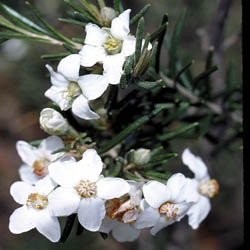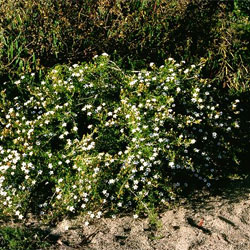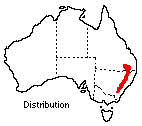Ricinocarpos bowmanii
 |
 |
Pink Wedding-bush, Western Wedding-bush
Ricinocarpos bowmanii F.Muell.
Ricinocarpos bowmanii is a delightful small shrub which is ideally suited to growing in a rockery, as a specimen plant, or against a background of taller shrubs. In spring and early summer the whole bush is conspicuously laden with clusters of starry white or pale pink flowers which have inspired the name of 'Pink Wedding Bush'.
 This
plant is a member of the large Euphorbiaceae family which has a world wide distribution.
It is an extremely variable family and includes many species of commercial importance.
Products such as rubber, dyes and oils are derived from some of its members.
This
plant is a member of the large Euphorbiaceae family which has a world wide distribution.
It is an extremely variable family and includes many species of commercial importance.
Products such as rubber, dyes and oils are derived from some of its members.
There are about sixteen species in the genus Ricinocarpos with the majority occurring in Western Australia but R. bowmanii is common in woodlands and on hillsides west of the Great Dividing Range in Queensland and New South Wales. It is a stiff rounded shrub growing to 1 m high by 1 m across with slender branches. The narrow olive-green leaves are alternate, to 20 mm long, with margins which are usually recurved to the midrib. The undersurfaces of the leaves are paler with closely matted short hairs.
The flowers have 5 spreading petals and are unisexual having separate male and female flowers on the same plant. The male flowers are produced in terminal clusters of 3 to 6 whilst the female flowers are borne alone or within the male clusters. The fruit is a globular capsule which splits open when ripe to release 3 mottled seeds.
This desirable plant is hardy, drought resistant and moderately frost resistant. For successful cultivation it requires a sheltered, well drained position in full sun or part shade. Plants which are thriving in the Australian National Botanic Gardens have been planted in the Rockery in a very well-drained growing medium, but they also grow in the natural soil.
Ricinocarpos bowmanii may be propagated from seed or cuttings. However, seed germination can be erratic and it is advisable to use fresh seed. Some success has been achieved by immersing the seeds in almost boiling water prior to sowing. Tip cuttings of half-ripened wood should be taken between January and March and can take up to eight weeks to strike. Cuttings should be treated with a hormone to promote root growth.
An application of a complete fertiliser in spring and autumn will increase the vigour of the plant and light pruning throughout the plant's development will help to retain its bushy habit. A light mulch of leaf litter is also beneficial.
Text by Effie Mullins, ANBG (1989)
Name meaning: Ricinocarpos bowmaniiRicinocarpos- from Ricinus (the castor oil plant) which is in the same family and carpos, fruit. bowmanii - after Edward M. Bowman (1826 - 1872), who collected the specimen from which this species was named. |
![An Australian Government Initiative [logo]](/images/austgovt_brown_90px.gif)

